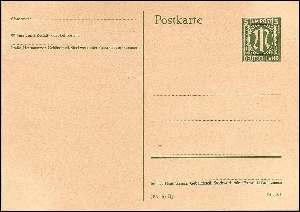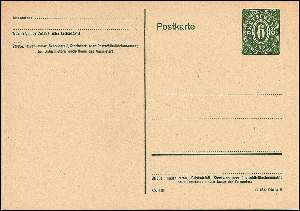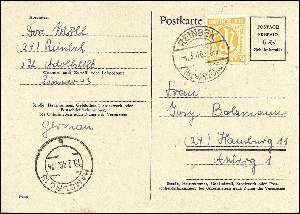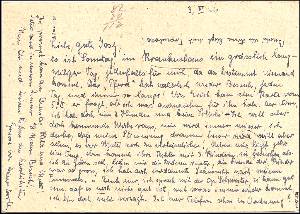

A is for AMG Stamps |
 |
 |
 |
 |
Allied Military Government stamps of post-WWII Europe
These mostly nondescript - some would say dull and ugly - stamps are an important part of a critical time in history, the period at the end of World War II when the Allied forces (basically Great Britain, the USSR, and the United States) were liberating occupied countries in Europe and defeating the Axis powers (primarily Japan, Germany, and Italy).
Who runs a defeated country? Or one that is liberated from occupation by an invader? Those are not questions one would think to ask ordinarily, as until recently war was a remote, history-book concept for most of us in prosperous Western nations. It is a far more immediate concern today (6/27/2004), as the "War on Terrorism" has liberated first Afghanistan from the Taliban, and then Iraq from Saddham Hussein, and who is to govern those devastated lands becomes an important issue. Probably the last time it was an issue on such a large scale was back in 1941, when the United States entered World War II after the bombing of Pearl Harbor. U.S. government and military officials in Washington realized that - for a short time, at least - the liberated and defeated countries of Europe would need assistance in making the transition to a free, independent status. For example, it would take time for them to produce and distribute new postage stamps, an issue quite relevant to the philatelic obsession of this web site.
Accordingly, military planners in the U.S. had the United States Bureau of Engraving and Printing (BEP) design and print special stamps (and currency) to be used in Europe during the post-War transition. These provide the basis for a complex and fascinating historical and philatelic collecting area, one that I became interested in about ten years ago, thanks to Joseph Bush's ads in the philatelic press. Those ads are still there, though Joe died a short time ago. His son Mike continues to run their business, and while I do not carry advertising per se in these pages, I like to credit my sources, and recognize the efforts of people I feel have made important contributions to the hobby, so I encourage you to write J. Bush (see bottom of page for info) if you want to learn more about AMG collecting.
AMG - Sicily
8/23/43 - 10/1/44

The first European nation to surrender to the Allies was Italy, in 1943. The AMG stamps prepared for use there were used for only a short time, and only in Sicily (hence these are sometimes called the Sicily Issue), as the transition to a civilian government went quickly and local stamps were available for most of the country when needed. The design of these stamps was the crudest, with a basic, generic design over which the country name and denominations were printed. Had other countries needed stamps sooner, this same design would have been used there as well, with different overprints.
AMG - Naples
December, 1943

AMG stamps of Naples, Italy, 1944
Stamps of Italy 1929-1942 issue - overprinted under authority of the AMG.
During the early days of December, 1943, the newspaper •Risorgimento• of Naples published the following notice:
Restoration of Postal Service
A restricted postal service, limited to the city of Naples will begin operating on December 10, 1943. The service will be limited to:
1. Postcards.
2. Invoices and statements in open envelopes provided these envelopes do not contain any correspondence.
The fee will be 50 centesimi. The name and address of the sender must be clearly shown on each postcard, envelope ...
On December 10, 1943, these overprinted Italian values were issued. They were locally overprinted in several different colors, by Richter and Company, Naples, Italy.
AMG - Bari
January, 1944

AMG stamps of Bari, Italy, 1944
Allied Military Government Sanctioned Provisional
Issued by the provisional Badoglio government under sanction of the Allied Military Government authorities.
First used in Bari, Italy, and then placed into use in localities elsewhere as each was liberated by the allied armies.
Although Badoglio was the nominal head of the provisional Italian government, his position was held only through the grace of the AMG authorities and he was guided strictly by the policies and decrees laid down by them.
AMG - France
10/8/44 - 5/12/45
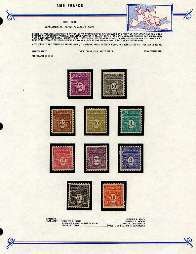
AMG stamps of France - First Issue - October, 1944
By the time France was liberated in late 1944, the BEP had been able to produce stamps that were country-specific, but the designs and production quality were still mediocre. Paper shortages, wartime work priorities, and the simple fact that the stamps were intended only for stopgap transitional usage all precluded anything better. Moreover, France was tired of living under a military government and wanted to return to complete independence as soon as possible, so the stamps were not well-received, and saw little use. The page shown above is one J. Bush produces, and is typical of his high-quality, informative approach to the material.
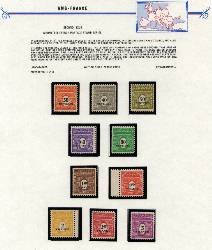
AMG stamps of France - Second Issue - 1945
Committee French postage stamp series
In accordance with the expressed wishes of the De Gaulle government, this second series was called the "Committee" series. Like its predecessor, it was prepared and printed by the US Bureau of Engraving and Printing.
Utilizing the original design of the first issue, the letters and numerals of value were removed; that part of the design that had been removed was redrawn: and a new plate was made to print the basic design without any value designation. This single plate was used to print all values in their respective colors. Ten new plates were prepared to print (or overprint) the value designations in black. The ten plates were assigned plate numbers which are found with the marginal inscriptions, also in black. The inscriptions are found only on the right margins of the right hand sheets of the four pane printed plate.
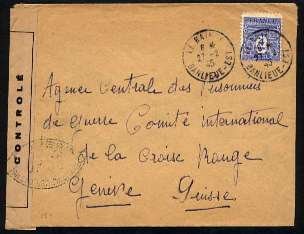
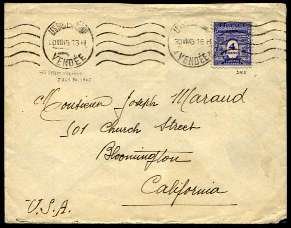
AMG - France cover, Feb 27, 1945
Valid non-philatelic solo uses of the AMG - France stamps are relatively scarce, and sell for twenty dollars and up, depending on the date and usage. The two above look like they might qualify. Obviously philatelic covers such as the ones below are more common, and sell for ten dollars or less.

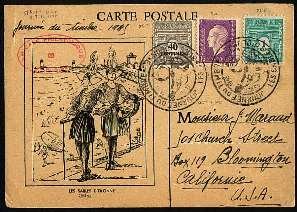
AMG - Germany
3/19/45 - 10/31/46

AMG stamps of Germany, 1945
Wasington printing
The AMG stamps had the longest lifetime and saw the most extensive use in Germany, since it was occupied for the longest period after the War. Moreover, Germany was the most devastated eastern European country, and the slowest to recover.
AMG stamps of Germany were printed in three places: frst, in Washington, D.C., at the U.S. Bureau of Printing and Engraving; second, after the war ended, and the Allied occupation of Germany began, in London; and finally, as Germany began to recover, in Brunswick, Germany. The designs are the same for all three issues, making them superficially identical, but different plates were used in each location, making differentiation among them straightforward, once one knows what to look for - small design differences, different papers, perforations, etc.

AMG - Germany cover, 1946?
Non-philatelic covers with the German AMG stamps are plentiful, as the stamps were used widely for at least two years. One attraction of the AMG - Germany stamps is the many printings, varieties, and errors. The stamps were printed in huge quantities not only in the U.S. but in England and Germany as well, and provide a rich field for the specialist.
AMG - Germany postal cards
AMG collector Clinton Many sent me the scans below, of AMG postal cards issued in Germany in the latter half of 1945. To facilitate processing of mail in this still chaotic period right after the Allied victory, mail was restricted to post(al) cards and one-page letters. The first two below were issued in the American Zone. The 5Pf value was for local mail, and the 6Pf was for mail to other locations within Germany. The indicia are based on the design used for the AMG-Germany stamps.
The card below, issued 9/26/1945 in Stuttgart, was the only AMG postal card that did not use the AM POST indicium.
The card below was issued in the British Zone as an emergency measure to meet the earliest needs. There is no indicium, simply the text indicating prepayment of postage.
By October these cards were ready in the British Zone, with the AM POST indicia.
On March 1, 1946 the postal rates were doubled to 10 pf. for intra-city mail, and 12 pf. for inter-city mail. The Gebühr bezahlt card below, mailed in Reinbek on March 4, 1946, reflects these new rates. A 6Pf adhesive was added to make up the 12Pf needed. Note the error in the date on the Hamburg receiving stamp - Feb. 19, 1946. The date on the message side - 3, III 46 - confirms that the March date is the correct one.
The above images represent only a small part of the AMG - Germany postal stationery story. There are other issues, and many varieties and types.
AMG - Austria
6/28/45 - 10/31/46
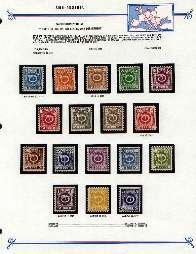
AMG stamps of Austria, 1945
Austria was regarded by some as a victim, by others as a supporter of Nazi aggression, but made the transition to independence quickly after the War. The AMG - Austria issues were printed only once in the U.S. and were quickly replaced by local issues.
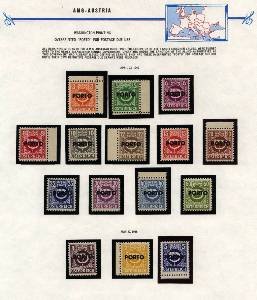
AMG stamps of Austria - PORTO overprint
Once local stamps had been issued, to avoid waste, unused stocks of the AMG-Austria stamps were overprinted "PORTO" and turned over to the newly-established Austrian government for use as postage due stamps.
AMG - VG
Venezia Giulia - 9/22/45 - 9/47

AMG stamps of Venezia Giulia
The area called Venezia Giulia (see map below) lies in the northeast corner of Italy where it meets what was in 1945 called Yugoslavia. Ownership of the region was a low priority for the Allies at the end of the War, but when things settled down a buffer zone called AMG - VG was created between Italy and Yugoslavia, with the intention that it would eventually be divided between the two countries. Stamps for the area were created by applying the AMG - VG overprint to current stamps of Italy.
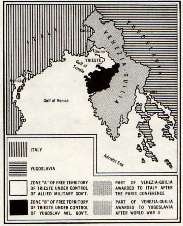
AMG - FTT
(Free Territory of Trieste) 1947 - 1954
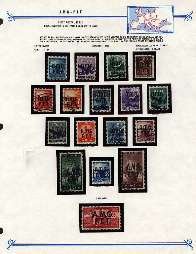
AMG stamps of FTT
In 1947 a formal peace treaty between Italy and Yugoslavia was finally signed, and most of AMG - VG was ceded to Yugoslavia. The one exception was the city of Trieste, which was declared a "free territory" and divided into two areas, one still to be administered by the AMG, the other by the Yugoslavs.
The AMG - FTT government created local stamps by overprinting issues of Italy. In addition, many special philatelic varieties were produced to cater to collectors, as the issues were popular at the time. One of the most attractive (though printed in small quantities and now expensive) such philatelic creations was the "Natale Triestino" issue of Christmas, 1953, shown below. In addition to the AMG - FTT overprint on the stamps themselves, a special overprint was added to the gutters between pairs of sheets, and these "gutter pairs" were sold to collectors. (P.S. - they're not cheap, as only 1,000 complete sets exist, so even though this is not a popular collecting area, you will have to pay upwards of $400 to own them. Still, how many stamps as scarce as that can you own for so little?)
One reason many U.S. collectors are interested in the AMG stamps is that the early issues were produced by the BEP. Some think these stamps deserve to be listed in the Scott U.S. Specialized catalog, as U.S. back-of-the-book stamps, rather than as footnotes to the various countries in which they were released. Thus far Scott has refused to make that change, arguing that who produced the stamps is irrelevant, it is where and how they were used that determines where they belong in the catalog. Regardless of how one classifies them, they represent an important chapter in world and philatelic history, and provide wonderful opportunities for learning and enjoyment.
The above is just a brief introduction to the topic of AMG stamps and collecting. I plan to expand on it as time permits. If you have knowledge or suggestions to contribute, please e-mail the webmaster at posterstampcc@gmail.com
See also my page O is for Overprints where I show a few more AMG stamps.
---------------------------------September, 2002
The following is a condensed version of an e-versation I had with Dr. Harry Wilcke, author of several of the key AMG texts and many articles about the AMG issues (see References, below).
Dear Bill,
I ran onto your philatelic web site through finding my name associated with AMG in a search that I was doing. I didn't have time to look at much of your other material, but I was interested in checking out the AMG section. You gave a nice introduction to that area of philately.
I first met Joe Bush in about 1978 or so, just as you did, through his ads. We became good friends and I worked for him in my spare time for about twenty years. I had the pleasure of visiting the Bushes in their home in Bonita on a number of occasions and got to know them rather well.
I did a vast amount of research and study on the AMGs for Joe's and my own edification over those years and wrote many articles for Linn's, American Philatelist and Possessions. I was AMG Section Editor for Possessions for several years and the UPPS published The AMG Story. Since we were able to provide camera ready material, the cost was minimal and the society made a profit on it. I revised the Bush AMG catalog a couple of times. I even wrote an AMG section for the Minkus US catalog but my work did not get included due to limited space.
While I enjoyed immensely working with the AMGs, I was not happy with the exhibiting of them. They are not regarded too highly within the upper crust of philately. In one exhibit, I showed a complete set of plate numbers from all of the BEP material, including the rare Austrian second printing on the 5 g. I believe that this garnered only a silver at the national level.
Ultimately, I did make it to gold with AMG doing the postal stationery of post-war Germany. This also won the Marcus White Trophy and a GPS award. Copies of my philatelic exhibits are in the library of the APS in State College, PA.
I wish to thank you for the lucid description of the AMGs and trust that there will be some collectors who get interested in this area after reading your material.
Some omissions - I notice that you did not mention the local Italian issues which appeared under the AMG: the Naples overprints and the Bari Wolf. Perhaps not too many people besides Joe Bush considered these AMG issues! I did a lot of work on both these and was fascinated by them.
Also I note that the second France Issue is missing. In their typical manner, the French had lots of complaints and so the BEP reprinted with values that they said they needed.. Even then, they didn't take to these stamps with much enthusiasm!
Then, a good portion of the Austrian issue was overprinted PORTO for use as postage dues which is worth a mention, I think.
Finally, the use of the BEP design on postal stationery in Germany is also of interest.
My heartfelt thanks to Dr. Wilcke for his comments. On 12/10/2005 I added examples of most of the other material he mentions, though I do not have any of the German postal cards. If any viewer can supply scans of those, I will be glad to add them here.
AMG CURRENCY
I mentioned at the top of this page that there was AMG currency as well, and since I own a few examples, I decided to show them here. Like the stamps, they are dull and utilitarian in design and execution, but the historic echoes they carry are to me powerful and moving.
AUSTRIA
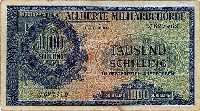
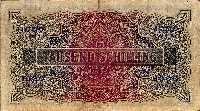
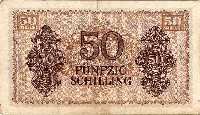
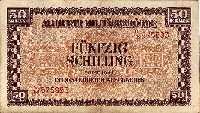
FRANCE
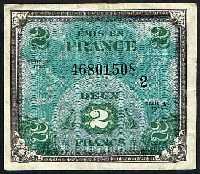

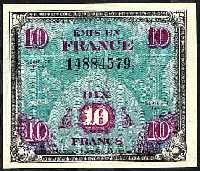





GERMANY

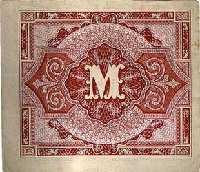
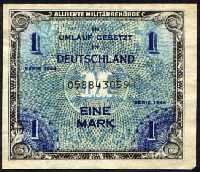


ITALY
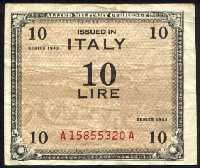

JAPAN
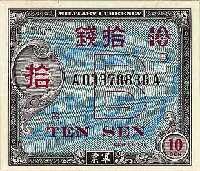


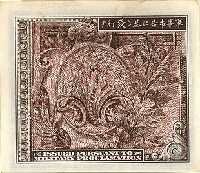
References
The album pages and map above are reproduced with the kind permission of
Joseph V. Bush, Inc.
PO Box 626
Bonita, CA 91908
(FAX: 619-479-0874)
If you want to learn more about AMG stamps, the following articles are a good starting point:
A Guide for AMG FTT Collectors, by Angelo G. Giumanini
The American Philatelist, May, 1989
The BEP Goes to War, by Harry W. Wilcke, M.D.
The American Philatelist, November, 1990
The Issues of the United States Allied Military Covernment in World War II, by Harry
W. Wilcke, M.D.
U.S. Stamps and Postal History,1997(?)
----------------------------
And here are a couple of excellent books, for those who want to go deeper:
The A.M.G. Stamps of Germany,
by F. Hugh Vallancey; Herman Herst, Jr., 1958
This is probably the earliest scholarly work on the subject, and while more recent books may be more complete or accurate, this one is still valuable and interesting for its perspective so soon after the end of WW II. It has extensive data on varieties for the specialist.
The AMG Story,
by Harry W. Wilcke, M.D.; The United States Possessions
Philatelic Society, 1994
This is an excellent recent work surveying all aspects of AMG philately, with good illustrations and historical information. It makes interesting reading, and provides an excellent overview of the topic. It is not, however, a catalog, and does not provide data on printing, varieties, errors, etc.
Send feedback to the webmaster: CLICK HERE
Created -- 11/23/2001
Revised -- 08/06/2025







